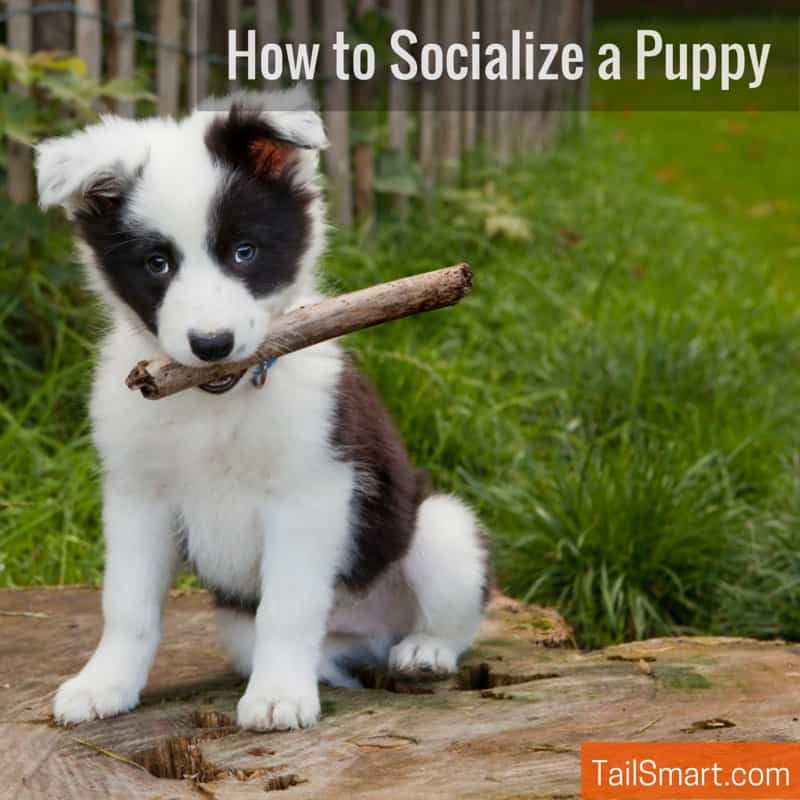
To help grow your puppy into a confident and happy dog that is relaxed in our modern human society, you need to socialize him. Socialization means you expose your puppy to a range of new experiences, including other animals, people, noises, sights, smells, and different environments. It’s very important to make each experience a pleasant one as you don’t want your puppy to develop phobias.
A dog that is not socialized well, may react in a frightened or aggressive way when encountering things he hasn’t seen before. A poorly socialized dog is also more stressed by his environment, less happy and not relaxed.
The best time to socialize a puppy is between 3 and 12 weeks old, in this period they are most accepting of new experiences. From 12 to 18 weeks, puppies become more cautious of new things, and with each passing week it becomes harder to get your dog to accept something new that he’s wary of.
Keep Your Puppy Safe
Although it’s vital to begin socializing early, you also don’t want him to get sick. Until your puppy’s full immunity is in place, he is at risk of catching diseases from other dogs so avoid places where other dogs play such as parks, dog events, or pet stores. Carry your dog in places where unknown animals have access, to prevent him from picking up diseases.
Avoid off-leash dog parks until your pup is at least 6 months old. As said earlier, it’s important that new experiences are pleasant. For a young dog the likelihood of a bad experience at an off-leash dog park is great, so they are best avoided until he’s a little older.
There are however, plenty of other places to go, people to see, and objects to investigate.
What To Do, Where To Go
There are a number of new experiences you can create at home for your puppy. Here are some ideas to get you started:
- Invite people (with or without immunized dogs) to meet your pup.
- Leave out boxes, umbrellas, vacuum cleaners, step ladders, rollerblades and such for exploration.
- Play videos or sounds for your dog.
- Get your dog used to grooming, including brushing, bathing, nail clipping and ear cleaning.
- Change things up a little, let the pup explore upside down chairs, put a bucket sideways on the floor, set-up the ironing board upside down, etc.
- Introduce your pup to your other pets or livestock early.
- If you have a yard, allow your pup to explore your gardening equipment.
- If you do not have children, be sure to invite some children over for a play with your puppy.
Even before immunization is in place, there are things you can do outside the home. Always keep your dog’s safety in mind but do go out and have some fun. Here’s a small list of outside ideas:
- Go for car rides, take the car through the car wash, the drive-through, different neighborhoods, etc.
- Go to a puppy socialization class (the trainer will know how to minimize the risk of infection).
- Hang out at the entrance of a shop or mall to meet strangers (allow them to feed your dog treats).
- Take your pup with you when visiting friends and family.
- Ride an elevator, go up stairs, walk through automatic doors or revolving doors.
- Take a walk through a busy car park to get used to cars and their noises and smells.
- Take your dog on a train or bus ride.
- Go to your local park to see joggers, skateboarders, and cyclists in action.
- Give your pup exposure to different environments and surfaces such as beach, grass, hiking trails, smooth surfaces in buildings or pet-friendly stores, carpets or rugs, etc.
Body Language
Keep a close eye on your pup’s body language. As you take him on outings and play with him at home, learn to recognize signs of stress and fear. If you catch his fears and worries early, you can change the experience into a positive one, rather than allowing a lifelong fear to develop. When you’re dog is too fearful or stressed, tone the new experience down a bit by moving further away, for example.
While you’re at it, check your own body language too. If you are nervous or worried, your dog will pick up on it. Be calm and confident when introducing your pup to new experiences, patiently allow him to explore and overcome his fears, and encourage him along the way.
Encourage Courage in Your New Puppy
If your puppy is afraid of a person or object he’s never seen before, do not reward that behavior by soothing him and petting him. You don’t want to teach your dog that it’s OK to be afraid and that it is something you want him to do. Instead act matter of factly and encouraging. Reward your puppy when he is being courageous and taking a step forward. As dogs really value food, you can offer a treat to him when he’s afraid of something so he redirects his thoughts from fear to the treat, but don’t cuddle and soothe.